
ABBAutomatic Transfer Switch
2.When the handle is attached, the automatic transfer switch will automatically be in
Manual mode and won’t operate automatically in case of line failure. The AUTO LED on the mimic panel is OFF.
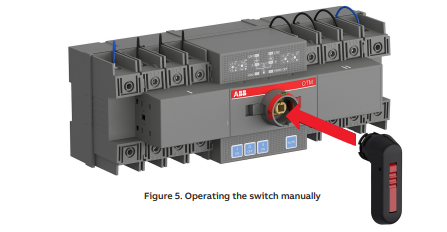

When the handle is inserted into the switch, the switch will enter “manual mode” with the automatic operation disabled.
Do not adjust wires when the transfer switch is being energized.
Before the power-on operation of the transfer switch, please operate the switch manually to confirm it is in normal function.
With the power supply function in “normal” and without the handle inserted and EMRG OFF signals, the initially energized switch will enter automatic mode and transfer to the main line. Keep the handle inserted if you do not want the switch to be in automatic mode upon initial energization
— 3.2 Automatic operation
OTM_C21D must be in automatic mode and the “AUTO” LED is on
in order that the switch can perform automatic transfer cycles according
to the pre-set operating mode.
To operate the switch electrically: • If the handle inserted
1. Press handle locking clip and remove the handle from the switch.
2. Press “AUTO” button and the “AUTO” LED will be ON, indicating automatic mode.
• If handle is not inserted
1. If “AUTO” LED blinks, press “AUTO” button and the “AUTO” LED will be ON, indicating automatic mode.
2. Automatic operation includes three operating modes: Line 1 priority (factory default setting), No line priority, and manual return mode.
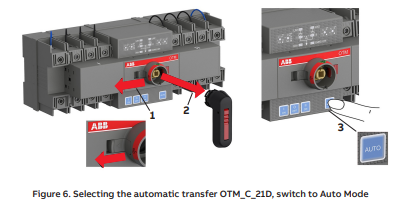
3.3 System testing
3.3.1 Local test
In automatic mode, “AUTO” LED is ON and you can transfer the switch using
I, O, and II push buttons on the front panel of the switch. Press “AUTO” button
to return the automatic operation.
3.3.2 Remote test
The procedure of the remote test is as follows:
1. Connect to the remote test signal according to Figure 7.
2. Ensure that the OTM_C21D is in automatic mode (“AUTO” LED is on).
3. Short circuit the remote test signal for at least 100 ms until the “AUTO” LED blinks to enter the test mode. Under test mode, the automatic transfer switch will simulate switching cycle and finally return to its original position prior to the activation of the test mode. e.g., when the switch is in Position I: Enter test signals; the switch transfers to Position O → to Position II → to Position O → to Position I. Entering test signals is invalid before the automatic transfer switch returns to its original position. Under test mode, press the “AUTO” button to cancel test mode and return to automatic mode. The “Auto” LED will be “ON” as normal.
4. After the remote test finishes, the OTM_C21D automatically returns to the automatic mode (“AUTO” LED is on).
3.4 Locking
3.4.1 Locking the electrical operation
The switch can be padlocked in any position, causing that all operating modes and test operations are disabled, and handle cannot be inserted. See below for operation:
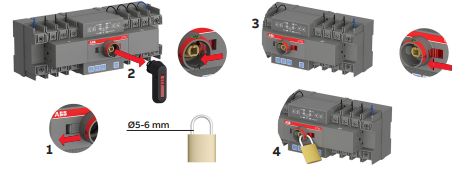
Figure 8. Locking the electrical operation
3.4.2. Locking the manual operation
By default, the manual operation can only be locked in position 0. The handle can be padlocked by pulling out the clip from the handle and place the padlock on the handle see Figure 9
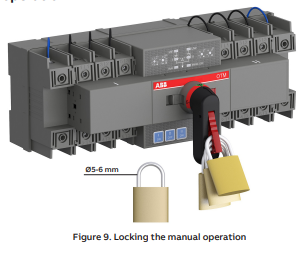
3.5 Modbus communication function
OTM_C21D can achieve communication function by using the optional external Modbus RTU module.
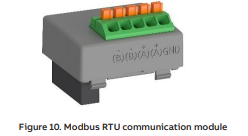
3.5.4 Cyber security
Disclaime
t is the sole responsibility of the customer to provide and continuously ensure a secure connection between the product and the customer network or any other network. The customer is required to establish and maintain any appropriate measures (including but not limited to the installation of firewalls, application of authentication measures, encryption of data, installation of anti- virus programs, etc.) to protect the product, the network, its system and the interface against any kind of security breach, unauthorized access, interference, intrusion, leakage and/ or theft of data or information. ABB and its affiliates are not liable for damage and/or losses related to such security breaches, unauthorized access, interference, intrusion, leakage and/or theft of data or information.
Secure Deployment
The user of the product should be aware that the unsecure nature of the serial Modbus protocol exposes the communication between the product and the control system. Encryption, authentication or integrity of transmitted data are not provided by the protocol. To prevent equipment to operate in an unsafe or undesirable manner due to malicious activities the product must be positioned in a trusted network, strictly limited and in a hosted portion of a network or control system. The recommendation is also to restrict physical access to the product/ system to only allow authorized people to make changes to the system. Besides, the user can setup system to trigger alarm when communication is interrupted (device stops responding) and check if there are any unsafe condition
4. Interface and Settings
4.1 Buttons

Figure 11. Buttons
Button Function Remarks













































.jpg)
.jpg)
.jpg)





.jpg)



.png)
.jpg)

.jpg)
_lVjBYb.jpg)

.jpg)
.jpg)



.jpg)
.jpg)







.jpg)

.jpg)
.jpg)











.jpg)




.jpg)
.jpg)
.jpg)
.jpg)
.jpg)
.jpg)

.jpg)

.jpg)
.jpg)
.jpg)






.jpg)


.jpg)






